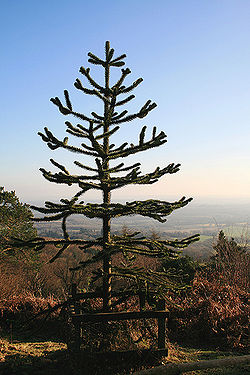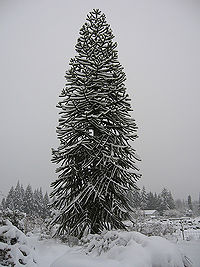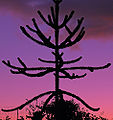Monkeypuzzle tree
| Monkeypuzzle tree |
|---|

|
| Scientific Classification |
|
| Binomial Name |
|
Araucaria araucana |
| Image Description |
The Monkeypuzzle tree is a species of conifer tree (Araucaria araucana) that is native to central Chile and west central Argentina in the Andes mountains. It is an evergreen tree that can grow all the way up to 40 m tall and up to 2 m in the trunks diameter. The tree is so old that many people consider it to be a living fossil. The Araucaria araucana or Monkeypuzzle Tree is also the national tree of Chile.
Anatomy
The Monkey Puzzle Tree can grow up to 45 meters high (150ft) and can have a diameter of 1.5 meters (5ft). The leaves of the Monkey Puzzle are rough and thick and have a triangular shape to them. They are usually about 3 to 4 cm in length and are 1 to 3 cm wide with the widest part of the leaf being at the base. The leaves themselves are very sharp which can protect them from some animals or certain other things that may harm the tree, such as humans. The leaves themselves can actually live anywhere from 10 to 15 years, but when the branch gets older it will lose its leaves. The branches of the monkey tree are long and a little curved. When you see a monkey tree it does not look like most trees you are used to seeing. The monkey tree is a more defined looking tree rather than its close relative, the evergreen, which has bigger branches and different leaves[1].
Reproduction
The tree is most usually dioecious, which means that the male and female cones are on separate trees, with the exception of some trees that some have found that have both male and female cones. The male tree's cones are shaped almost like a cucumber. They are about 4 cm long at the beginning of its life and then grow to anywhere from 8 to 12 cm long and are 5 to 6 cm wide at the pollen releasing point. Just like all of the other conifers, the monkey tree is wind pollinated, which means the pollen from the male cone is carried by the wind to the other trees. The female cones, are globose, or large, and can grow anywhere from 12 to 20 cm in width. They can hold almost 200 seeds inside. The cones will rot at maturity in order to release the 3 to 4 cm long nut-looking seeds, which are then carried on by Blue Jays and squirrels. The nuts themselves are edible and taste almost like pine nuts. The seeds look like cashews, can be eaten raw or cooked, and are full of starch. Many people harvest the seeds in autumn, and the seeds will last to almost 9 months[2].
Ecology
The monkey puzzle's native habitat is in the lower slopes of the Chilean and Argentinian south-central Andes Mountains[3]. The tree can usually be found above 1000 m. The tree likes areas where there is heavy snowfall in the winter, but it can withstand the heat as well. The tree itself is a very strong tree, therefore it is able to survive such harsh conditions. The younger trees can be found all over the place, and the young tree starts to grow in an umbrella shape. Once that is done, the tree will then grow the rest of itself as it gets older. The trees usually like to be in a slightly acidic volcanic soil, but can also grow in any soil as long as it is a well drained area since the tree is not able to grow underwater like other trees.
Other
The Monkey puzzle was first found in Chile and was originally named Pinus araucana by Molina in 1782. Later on in 1789, de Jussieu created a new genus of the tree called Araucaria which was the name that was used for a while. The tree had several name changes over the years and finally in 1873 Koch came up with its newest and final name which is Araucaria araucana. The name araucana comes from the native Araucano People who lived in Chile and used the nuts from the tree for food. The origin of the English name for the tree, Monkey-puzzle, comes from the earlier times when the tree itself was still a very rare tree in many of the gardens. The owner of a young tree located at the Pencarrow garden was showing it to a group of friends, when suddenly one of them stated that it would puzzle even a monkey to climb that tree. Ever since that witty remark, people have been calling it the Monkey Puzzle.
Gallery
 Browse |
References
- Monkey Puzzle Wikipedia. 2009
- Araucaria araucana Rich Morris. 1996-2008
- Monkey Tree Dave. 2000-2009
- The Monkey File Lee R. Berger 2009







